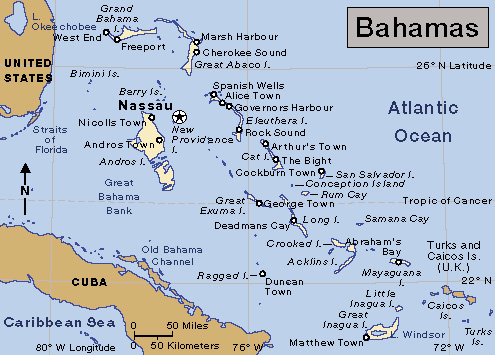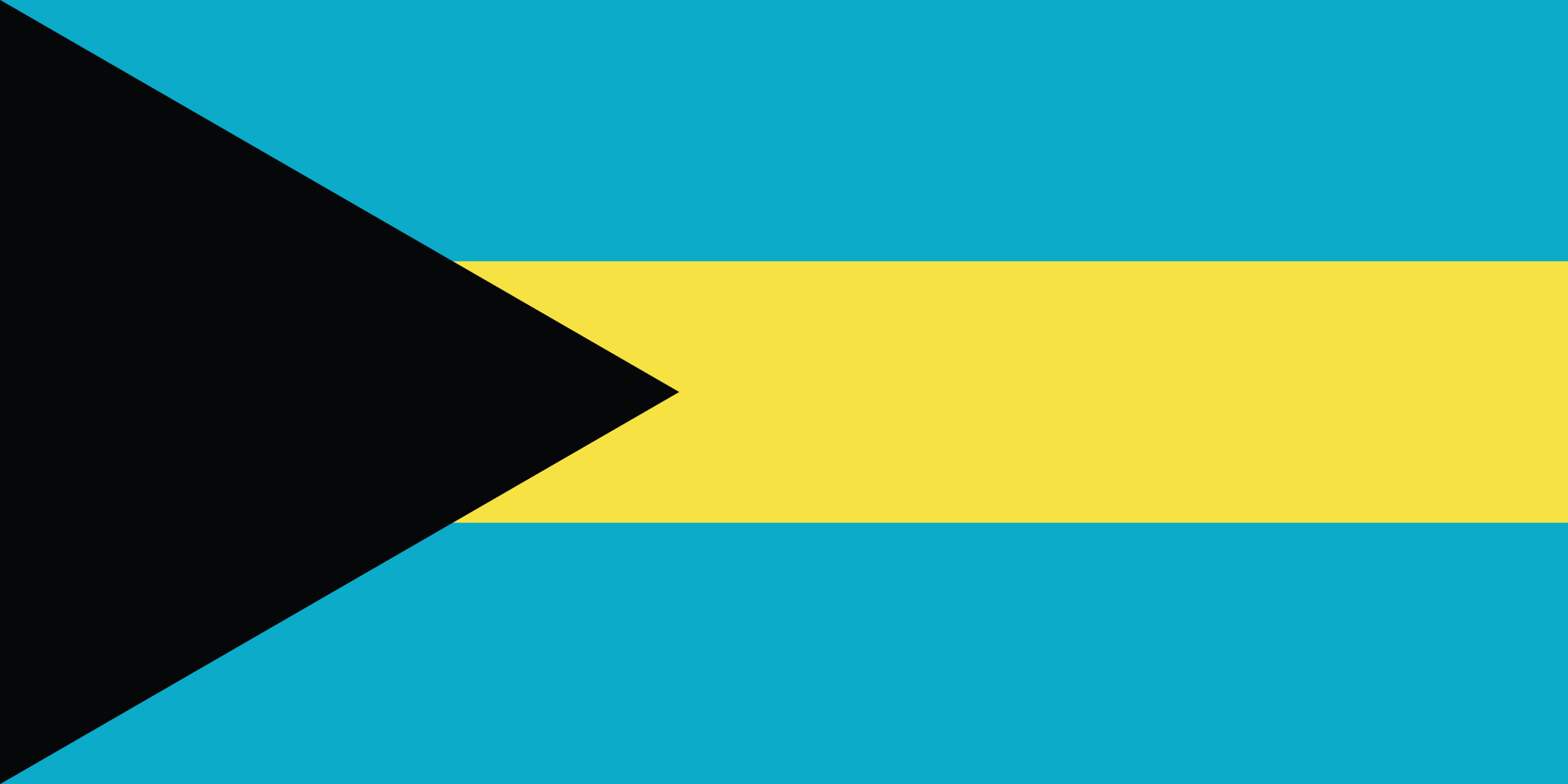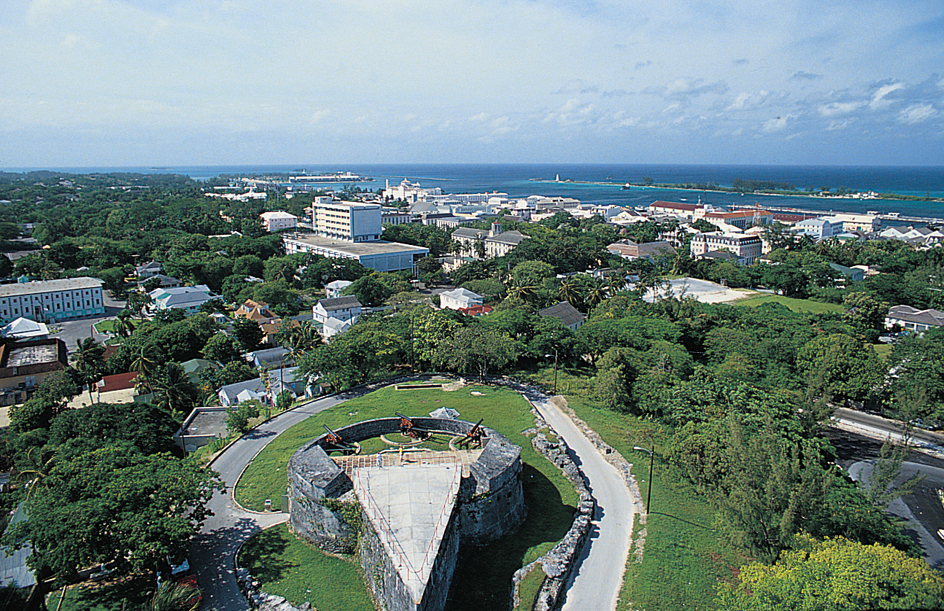Bahamas << buh HAH muhz >> are a chain of about 3,000 coral islands and reefs that make up an independent nation in the West Indies. They extend from about 50 miles (80 kilometers) off the eastern coast of Florida to the northeastern tip of Cuba, a distance of over 500 miles (800 kilometers). Only about 20 of the islands are inhabited. About 85 percent of the Bahamian people live on two of the islands—New Providence and Grand Bahama. Nassau, the capital and largest city, lies on New Providence. The beauty and mild climate of the Bahamas have helped make tourism the basis of the economy.

On his voyage to America in 1492, Christopher Columbus landed first at what is now San Salvador Island in the Bahamas. The Bahamas were a British colony from 1717 to 1973, when they gained independence.
Government.
The Commonwealth of the Bahamas is a constitutional monarchy. The British monarch is the official head of state. A governor general represents the monarch in the Bahamas. The two-house legislature consists of the House of Assembly and the Senate. Voters elect members of the Assembly to five-year terms. The head of the party that holds the most seats in the Assembly serves as prime minister. Senators are appointed by the governor general on the advice of the prime minister and the opposition leader.

People.
Black people make up about 90 percent of the Bahamian population. Many of them are descendants of enslaved workers brought to the islands by British loyalists who left the United States after the American Revolution (1775-1783). The rest of the Bahamian population consists chiefly of white people and people with both African and European ancestry.
Almost all Bahamian adults can read and write. The law requires children from 5 to 14 to go to school. Religious groups in the Bahamas include Anglicans, Baptists, Methodists, and Roman Catholics.
Land and climate.
The Bahamas consist of nearly 700 islands and about 2,300 rocky islets and reefs. The principal islands include Acklins, Andros, Cat, Eleuthera, Grand Bahama, Great Abaco, Great Exuma, Great Inagua, Little Abaco, New Providence, and San Salvador. Most of the Bahamas are long, narrow strips of limestone covered by a thin layer of stony, barren soil. Pine forests cover parts of many of the islands.
The Bahamas have a mild climate. Temperatures average about 72 °F (22 °C) during the winter and about 85 °F (29 °C) in summer. An average of about 45 inches (114 centimeters) of rain falls annually.
Economy.
Tourism ranks as the leading economic activity of the Bahamas. Many Bahamians work in hotels or in other businesses related to tourism. Banking is also important to the country’s economy. The Bahamas has branches of many foreign banks.
A small percentage of Bahamian workers farm the land. Farmers grow bananas, citrus fruits, sugar cane, and tomatoes and other vegetables. They also raise chickens for eggs and meat. Fishermen catch crawfish and other seafood for local use and for export. The country must import most of its food.
Manufacturing contributes a small amount to the Bahamian economy. The country imports many manufactured goods from the United States and other countries.
Cargo and passenger ships sail among the Bahamian islands and to and from other countries. Nassau is the country’s chief port. Lynden Pindling International Airport in Nassau, the main airfield, handles local and international flights.
History.
Indigenous (native) Lucayo people lived in what are now the Bahamas long before Europeans arrived there. In 1492, Christopher Columbus landed at San Salvador Island and claimed it for Spain. The Spanish did not settle in the Bahamas. But they enslaved the Lucayo and took many of them to work in gold mines on the nearby islands of Cuba and Hispaniola. The Bahamas then remained mostly uninhabited until the mid-1600’s, when the British began to settle there.

At first, Spain did not challenge the British settlement of the Bahamas. But beginning in the late 1600’s, Spanish forces attacked the British settlements several times. Pirates who used the Bahamas as a base for their expeditions also raided the British communities.
The Bahamas became a British colony in 1717. In time, the colonial government succeeded in defending the Bahamas against pirate attacks. Spain gave up its claim to the islands in 1783, under the Treaty of Paris. After the American Revolution, many British loyalists left the United States and settled in the Bahamas. They brought their enslaved workers and set up plantations. In 1833, an act of the British Parliament outlawed slavery.
During the American Civil War (1861-1865), the Bahamas gained prosperity as a base for ships breaking the Union blockade of Confederate ports. These blockade runners carried on a profitable trade between the Confederacy and Europe. After the war, the Bahamas went through a period of economic decline. This period lasted until the mid-1900’s, when large numbers of tourists began to visit the islands.
The United Kingdom granted the Bahamas internal self-government in 1964. In 1967 legislative elections, the Progressive Liberal Party (PLP), composed largely of Black people, won control of the government. The PLP brought Black majority rule to the islands for the first time. The party, led by Prime Minister Lynden O. Pindling, worked to gain independence for the Bahamas. The Bahamas became independent on July 10, 1973.
Pindling served as prime minister until 1992, when the Free National Movement (FNM) won control of the government. Since that time, either the FNM or the PLP has formed the government.
In 2019, Hurricane Dorian devastated much of Grand Bahama and the Abaco islands in the northwestern part of the country. The hurricane was one of the strongest on record to ever strike the Bahamas. More than 70 people were killed, and many others were reported missing. 
See also Caribbean Islands; Nassau; Pindling, Sir Lynden.
